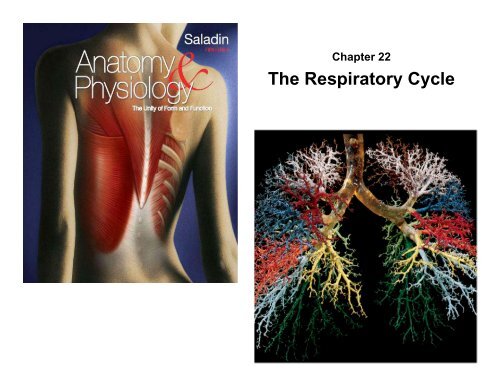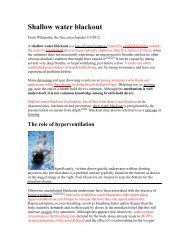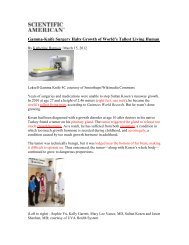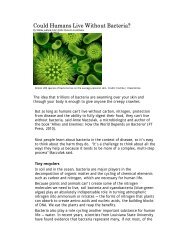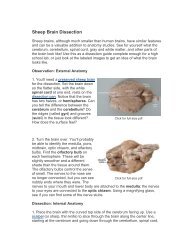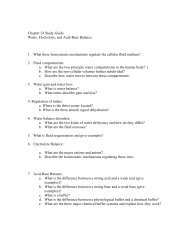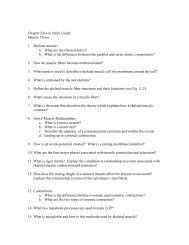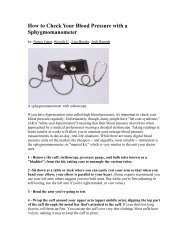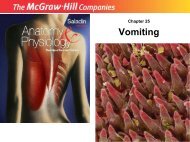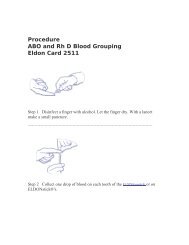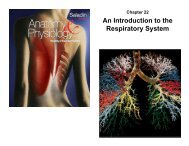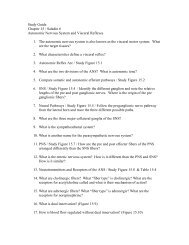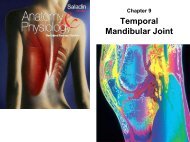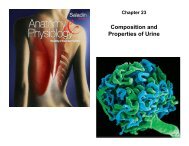The Respiratory Cycle
The Respiratory Cycle
The Respiratory Cycle
- No tags were found...
Create successful ePaper yourself
Turn your PDF publications into a flip-book with our unique Google optimized e-Paper software.
Chapter 22<br />
<strong>The</strong> <strong>Respiratory</strong> <strong>Cycle</strong>
Pressure and Airflow<br />
• respiratory airflow is governed by the same<br />
principles that regulate blood flow: pressure,<br />
and resistance<br />
– the flow of a fluid is directly proportional to the<br />
pressure difference between two points<br />
– the flow of a fluid is inversely proportional to the<br />
resistance<br />
• atmospheric pressure<br />
– the weight of the air above us<br />
– 760 mm Hg at sea level - 1 atmosphere (atm)<br />
• Force exerted by one square inch of “air” between the<br />
ground and all the space above it!<br />
• Lower at higher elevations<br />
• <strong>The</strong> pressure “gradient” between atomospheric<br />
pressure and the pressure within the “pleura space”<br />
(intra pleura pressure) is what drives respiration
Physics, Inspiration & Respiration<br />
• Boyle’s Law – at a constant temperature,<br />
the pressure of a given quantity of gas is<br />
inversely proportional to its volume<br />
– if the lungs contain a quantity of a gas<br />
and the lung volume increases<br />
• their internal pressure (intrapulmonary<br />
pressure) falls<br />
• if the pressure falls below atmospheric<br />
pressure the air moves into the lungs<br />
– if the lung volume decreases<br />
• intrapulmonary pressure rises<br />
• if the pressure rises above atmospheric<br />
pressure the air moves out of the lungs
Inspiration & Boyle’s Law<br />
• the two pleural layers, their cohesive attraction to each<br />
other, and their connections to the lungs and their<br />
lining of the rib cage bring about inspiration<br />
– when the ribs swing upward and outward during<br />
inspiration, the parietal pleura follows them<br />
– the visceral pleura clings to it by the cohesion of water<br />
and it follows the parietal pleura<br />
– it stretches the alveoli within the lungs<br />
– the entire lung expands along the thoracic cage<br />
– as intrapleural volume increase<br />
• its internal pressure drops<br />
• air flows in
Inspiration & Boyle’s Law<br />
• intrapleural pressure – the slight vacuum that exists<br />
between the two pleural layers<br />
– about -4 mm Hg<br />
– drops to -6 mm Hg during inspiration as parietal pleura pulls<br />
away<br />
– some of this pressure change transfers to the interior of the<br />
lungs<br />
• intrapulmonary pressure – the pressure in the alveoli drops -3<br />
mm Hg<br />
• pressure gradient from 760 mm Hg atmosphere to 757 mm Hg in<br />
alveoli allows air to flow into the lungs
Physics, Inspiration & Charles’s Law<br />
• Charles’s Law<br />
– the given quantity (volume) of a gas is directly proportional<br />
to its absolute temperature<br />
– on a cool day, 16°C (60°F) air will increase its temperature<br />
by 21°C (39°F) during inspiration<br />
– inhaled air is warmed to 37°C (99° F) by the time it<br />
reaches the alveoli<br />
– inhaled volume of 500 mL will expand to 536 mL<br />
– thermal expansion will contribute to the inflation of the<br />
lungs<br />
• in quiet breathing<br />
– dimensions of the thoracic cage increase only a few<br />
millimeters in each direction<br />
– enough to increase its total volume by 500 mL.<br />
– 500 mL of air flows into the respiratory tract
Expiration<br />
• relaxed breathing<br />
– passive process achieved mainly by the elastic<br />
recoil of the thoracic cage<br />
– recoil compresses the lungs<br />
– volume of thoracic cavity decreases<br />
– raises intrapulmonary pressure to about +3 mm<br />
Hg<br />
– air flows down the pressure gradient and out of<br />
the lungs<br />
• forced breathing<br />
– accessory muscles raise intrapulmonary pressure<br />
as high as +30 mmHg<br />
– massive amounts of air moves out of the lungs
<strong>Respiratory</strong> <strong>Cycle</strong><br />
Copyright © <strong>The</strong> McGraw-Hill Companies, Inc. Permission required for reproduction or display.<br />
No airflow<br />
Atmospheric pressure 760 mm Hg<br />
Pleural cavity<br />
Diaphragm<br />
Intrapulmonary pressure 760 mm Hg<br />
Intrapleural pressure 756 mm Hg<br />
Ribs swing upward<br />
like bucket handles<br />
during inspiration.<br />
1<br />
At rest, atmospheric and<br />
intrapulmonary pressures<br />
are equal, and there is<br />
no airflow.<br />
Ribs swing downward<br />
like bucket handles<br />
during expiration.<br />
2 Inspiration<br />
4 Pause<br />
Airflow<br />
Airflow<br />
Intrapleural<br />
pressure –6 mm Hg<br />
Intrapulmonary<br />
pressure –3 mm Hg<br />
Intrapleural<br />
pressure –4 mm Hg<br />
Intrapulmonary<br />
pressure +3 mm Hg<br />
Diaphragm flattens<br />
3 Expiration<br />
Diaphragm rises<br />
Rib<br />
Sternum<br />
Ribs elevated, thoracic<br />
cavity expands laterally<br />
Sternum<br />
Rib<br />
Sternum swings up,<br />
thoracic cavity expands<br />
anteriorly<br />
Rib<br />
Sternum<br />
Ribs depressed, thoracic<br />
cavity narrows<br />
Sternum<br />
Rib<br />
Sternum swings down,<br />
thoracic cavity contracts<br />
posteriorly<br />
2 In inspiration, the thoracic cavity expands laterally,vertically<br />
3 In expiration, the thoracic cavity contracts in all three directions;<br />
and anteriorly; intrapulmonary pressure drops 3 mm Hg below<br />
intrapulmonary pressure rises 3 mm Hg above atmospheric<br />
atmospheric pressure, and air flows into the lungs.<br />
pressure, and air flows out of the lungs.
Airflow (1 of 2)<br />
• pressure is one determinant of airflow<br />
• resistance is the other<br />
– the greater the resistance the slower the flow<br />
• three factors influencing airway resistance<br />
– (1) diameter of the bronchioles<br />
• bronchodilation – increase in the diameter of a<br />
bronchus or bronchiole<br />
– epinephrine and sympathetic stimulation stimulate<br />
bronchodilation<br />
– increase air flow<br />
• bronchoconstriction – decrease in the diameter of a<br />
bronchus or bronchiole<br />
– histamine, parasympathetic nerves, cold air, and<br />
chemical irritants stimulate bronchoconstriction<br />
– suffocation from extreme bronchoconstriction<br />
brought about by anaphylactic shock and asthma
Resistance to Airflow (2 of 2)<br />
– (2) pulmonary compliance<br />
• the ease with which the lungs can expand<br />
• the change in lung volume relative to a given<br />
pressure change<br />
• compliance reduced by degenerative lung diseases<br />
in which the lungs are stiffened by scar tissue<br />
– (3) surface tension of the alveoli and distal<br />
bronchioles<br />
• surfactant – reduces surface tension of water<br />
• infant respiratory distress syndrome (IRDS) –<br />
premature babies<br />
• See next slide!
More About Alveolar Surface Tension<br />
• thin film of water needed for gas exchange (Henry’s Law)<br />
– Thin film of water creates surface tension<br />
– Force that must be overcome to expand lung tissue<br />
– Force that acts to collapse alveoli and distal bronchioles<br />
(along with elastic component of lung tissue)<br />
• pulmonary surfactant produced by the great alveolar cells<br />
– decreases surface tension by disrupting the hydrogen bonding<br />
in water<br />
– As lungs collapse, thickness of water within alveoli thickens,<br />
more layers of water molecules stack on top of each other to<br />
form 3D lattice of water molecules interconnected by H<br />
Bonds. Surfactant disrupts this lattice making reinflation of<br />
lungs easier!!!<br />
• premature infants that lack surfactant suffer from infant<br />
respiratory distress syndrome (IRDS)<br />
– great difficulty in breathing<br />
– treated with artificial surfactant until lungs can produce own


